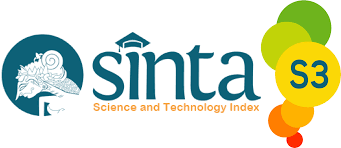Key Factors Impacting Profitability in Indonesian Commercial Banks: Financial Ratio, Macroeconomic, and Ownership Structure
Abstract
Profitability is essential for assessing company performance and attracting investors. This study aims to examine the effect of non-interest income, size, loan loss provision, capital adequacy ratio, overheads, non-performing loans, inflation, interest rate, and foreign ownership on the profitability of commercial banks in Indonesia. Using a quantitative approach, secondary data from the Indonesia Stock Exchange, Central Bureau of Statistics, Bank Indonesia, and company websites were analyzed over seven years (2017-2023) from 32 commercial banks, resulting in 224 financial statement data points. Panel data regression analysis with Eviews 12 was employed. The results indicate that non-interest income, size, inflation, interest rate, and foreign ownership do not significantly affect profitability. However, loan loss provision, capital adequacy ratio, overheads, and non-performing loans significantly impact profitability. These findings highlight the importance of managing problematic loans, maintaining a robust capital adequacy ratio, and improving operational efficiency to enhance profitability. The study suggests that company managers should also consider other factors such as financing decisions, asset utilization, tangibility, sales growth, and age to maximize profitability. Future research should explore different sectors and extend the study period to identify additional factors influencing corporate profitability, thereby providing deeper insights for strategic decision-making to improve financial performance.
Downloads
References
Abdou, D. M. S., & Alarabi, Y. (2024). The dynamics behind private banking growth in Egypt. Future Business Journal, 10(1). https://doi.org/10.1186/s43093-023-00290-5
Aboagye-Otchere, F., & Boateng, P. Y. (2023). Financing decision, ownership type and financial performance of listed non-financial companies in Ghana. Cogent Business and Management, 10(1). https://doi.org/10.1080/23311975.2023.2170070
Abu Khalaf, B., Awad, A. B., & Ellis, S. (2024a). The Impact of Non-Interest Income on Commercial Bank Profitability in the Middle East and North Africa (MENA) Region. Journal of Risk and Financial Management, 17(3). https://doi.org/10.3390/jrfm17030103
Akentara, R., Appiah Amankwa, I., & Awuma, W. (2024). The Impact of Capital Adequacy and Corporate Governance on Financial Performance of Universal Banks in Ghana. European Journal of Science, Innovation and Technology, 4(2). www.ejsit-journal.com
Annor, E., & Obeng, F. (2018). Impact of Credit Risk Management on the Profitability of Selected Commercial Banks Listed on the Ghana Stock Exchange. Journal of Economics, Management and Trade, 20(2), 1–10. https://doi.org/10.9734/jemt/2017/36881
Antwi, F. (2019). Capital Adequacy, Cost Income Ratio and Performance of Banks in Ghana. International Journal of Academic Research in Business and Social Sciences, 9(10). https://doi.org/10.6007/ijarbss/v9-i10/6471
Bilal, Z., AlGhazali, A., & Samour, A. (2024). GCC banks liquidity and financial performance: does the type of financial system matter? Future Business Journal, 10(1), 57. https://doi.org/10.1186/s43093-024-00348-y
El Moussawi, C., Goutte, S., Kouki, I., & Obeid, H. (2024). Assessing the impact of the expansion of pan-African banks and the institution’s quality on African banking stability. In Research in International Business and Finance (Vol. 70). Elsevier Ltd. https://doi.org/10.1016/j.ribaf.2024.102283
Elgi, A., Bumantara, T. S., & Sembiring, W. A. Br. (2023). Faktor-Faktor yang Berpengaruh pada Profitabilitas Perbankan. Journal of Management and Bussines (JOMB), 5(1), 177–189. https://doi.org/10.31539/jomb.v5i1.5255
Faheem, M., Zia, S. M., Raza, H., & Khan, A. (2024a). Macroeconomic Indicators and Pakistan’s Banking Industry’s Shock Absorbing Capacity A Case Study of Conventional and Islamic Banks. International Journal of Trends and Innovations in Business & Social Sciences, 2(1), 77–86. https://doi.org/10.48112/tibss.v2i1.670
Islam, S., & Shohel Rana, M. (2019). Determinants of Bank Profitability: Evidence from Commercial Banks of Bangladesh. Journal of Asian Business Strategy, 9(2), 174–183. https://doi.org/10.18488/journal.1006.2019.92.174.183
Javaid, M. E. (2016). Bank Specific and Macroeconomic Determinants of Bank Profitability. Journal of Management Info, 3(2), 14–18. https://doi.org/10.31580/jmi.v10i1.46
Jiraporn, P., Jumreornvong, S., & Chang Jung, S. (2019). The Impact of Ownership Structure on Bank Performance and Risk: Evidence from ASEAN. Journal Administration and Business.
Kelmendi, V. (2024). Impact of Macroeconomic Factors on Bank Financial Performance: A Turkey and Kosovo Comparative Study. International Journal of Sustainable Development and Planning, 19(1), 229–235. https://doi.org/10.18280/ijsdp.190121
Lamothe, P., Delgado, E., Solano, M. A., & Fernández, S. M. (2024). A global analysis of bank profitability factors. Humanities and Social Sciences Communications, 11(1). https://doi.org/10.1057/s41599-023-02545-6
Mantik, J., Susanto Hendiarto1, R., Gunawan2, D. A., & Susanto Hendiarto, R. (2024). The effect of inflation and interest rate on profitability of PT Bank BNI period 2010-2020. In Jurnal Mantik (Vol. 8, Issue 1). Online.
Minh, S. N., & Thanh, T. T. T. (2020). Analysis of the impact from non-interest income to the operational efficiency of commercial banks in Vietnam. Management Science Letters, 10(2), 455–462. https://doi.org/10.5267/j.msl.2019.8.025
Mirović, V., Kalaš, B., Milenković, N., Andrašić, J., & Đaković, M. (2024). Modelling Profitability Determinants in the Banking Sector: The Case of the Eurozone. Mathematics, 12(6). https://doi.org/10.3390/math12060897
Mulbah, K. T., Kurbonov, S., & Nasriddinov, B. (2024). The Effect of Bank Size, Net Interest Margin, and Capital Adequacy Ratio on Commercial Banks’ Return on Assets: Empirical Evidence from Tanzania. European Scientific Journal ESJ, 28. https://doi.org/10.19044/esipreprint.4.2024.p474
Ovamba Kiganda, E. (2014). Effect of Macroeconomic Factors on Commercial Banks Profitability in Kenya: Case of Equity Bank Limited. In Journal of Economics and Sustainable Development www.iiste.org ISSN (Vol. 5, Issue 2). www.iiste.org
Ozili, P. K., & Ndah, H. (2024). Impact of financial development on bank profitability. Journal of Economic and Administrative Sciences, 40(2), 238–262. https://doi.org/10.1108/jeas-07-2021-0140
Phan, H. T., Hoang, T. N., Dinh, L. V., & Hoang, D. N. (2020). The Determinants of Listed Commercial Banks’ Profitability in Vietnam. Journal of Asian Finance, Economics and Business, 7(11), 219–230. https://doi.org/10.13106/jafeb.2020.vol7.no11.219
Quy, V. T., & Tuan, P. D. (2024). Determinants of a bank’s profitability with the mediating role of interest rate spread: A case of Vietnam. Asian Economic and Financial Review, 14(5), 339–355. https://doi.org/10.55493/5002.v14i5.5041
Rashid, A., & Jabeen, S. (2016). Analyzing performance determinants: Conventional versus Islamic Banks in Pakistan. Borsa Istanbul Review, 16(2), 92–107. https://doi.org/10.1016/j.bir.2016.03.002
Saklain, M. S., & Williams, B. (2024). Non-interest income and bank risk: The role of financial structure. Pacific Basin Finance Journal, 85. https://doi.org/10.1016/j.pacfin.2024.102352
Serwadda, I. (2018). Determinants of commercial banks’ profitability. Evidence from Hungary. Acta Universitatis Agriculturae et Silviculturae Mendelianae Brunensis, 66(5), 1325–1335. https://doi.org/10.11118/actaun201866051325
Takahashi, F. L., & Vasconcelos, M. R. (2024). Bank efficiency and undesirable output: An analysis of non-performing loans in the Brazilian banking sector. Finance Research Letters, 59. https://doi.org/10.1016/j.frl.2023.104651
Tarmizi, M. (2023). EKONOMETRIKA MODEL & APLIKASI.
Tharu, N. K., & Shrestha, Y. M. (2019). The influence of bank size on profitability: An application of statistics. International Journal of Financial, Accounting, and Management, 1(2). https://doi.org/10.35912/ijfam.v1i2.82
Toha, M., & Aini, Q. (2022). Analysis Customers’ Interest to IB Faedah Savings. Majapahit Journal of Islamic Finance and Management, 1(2), 151-163. https://doi.org/10.31538/mjifm.v1i2.19
Toha, M., & Rozikin, K. (2020). Implementasi Maqasid Al-Shari’ah Dalam Manajemen Strategis Syariah. JES (Jurnal Ekonomi Syariah), 5(1). https://doi.org/10.30736/jesa.v5i1.75
Vebriana, A., Setyowati, V., & Ali Nurdin, A. (2020). Pengaruh Non-Performing Loan dan Loan to Deposit Ratio terhadap Cadangan Kerugian Penurunan Nilai Effect of non-performing loan and loan to deposit rasio to loan loss provision. Indonesian Journal of Economics and Management, 1(1), 245–254. www.idx.com.
Vo Thi Thuy Vy, & Vo Hoang Diem Trinh. (2016). The Impact Of Foreign Ownership On Profitability Of Vietnamese Firms Listed On Ho Chi Minh Stock Exchange.
Weinechita Pelealu, I., & Worang, F. G. (2018). Analysis The Effect Of Loan Loss Provision On Bank Profitability Analisa Dampak Cadangan Kerugian Penurunan Nilai Terhadap Profitabilitas Bank. Jurnal EMBA, 6(4), 3278–3287.
Yakubu, I. N. (2019). Does corruption grease or sand the wheels of bank profitability in Ghana? Cogent Economics and Finance, 7(1). https://doi.org/10.1080/23322039.2019.1701909
Yudha, A., Chabachib, M., Rini, I., & Pangestuti, D. (2017). Analysis Of The Effect Of Npl, Nim, Non Interest Income, And Ldr Toward Roa With Size As Control Variables (Differences Study on Domestic and Foreign Banks Listed on BEI Period 2010-2015). Jurnal Bisnis STRATEGI •, 26(2), 100–113.
Copyright (c) 2024 Amalia Mega Berliana, Grecia Alvionita Simanjorang, Villia Nikmatul Khasanah, Henny Setyo Lestari, Farah Margaretha

This work is licensed under a Creative Commons Attribution-ShareAlike 4.0 International License.
Authors who publish with this journal agree to the following terms:
- Authors retain copyright and grant the journal right of first publication with the work simultaneously licensed under a Creative Commons Attribution License that allows others to share the work with an acknowledgment of the work's authorship and initial publication in this journal.
- Authors are able to enter into separate, additional contractual arrangements for the non-exclusive distribution of the journal's published version of the work (e.g., post it to an institutional repository or publish it in a book), with an acknowledgment of its initial publication in this journal.
- Authors are permitted and encouraged to post their work online (e.g., in institutional repositories or on their website) prior to and during the submission process, as it can lead to productive exchanges, as well as earlier and greater citation of published work.


















